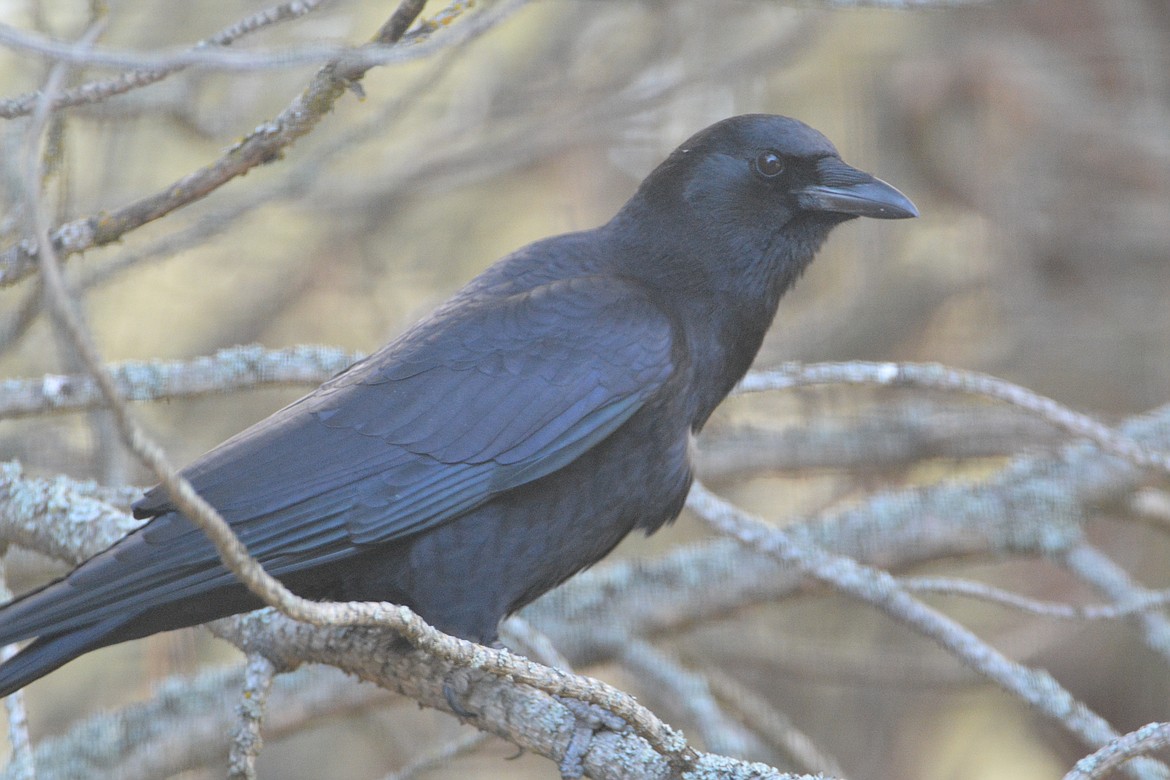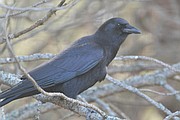Raven or crow? Here's how you know
When Edgar Allen Poe had to find a bird annoying enough to drive a man insane, the choice was easy: a raven. Corvids — the avian family that includes ravens and crows — are notorious for causing mischief to humans and animals alike.
The American crow and the common raven are two of the most recognizable birds in Idaho, but how do you tell them apart? Crows and raven, although in the same genus (corvus) are different birds. (Think of leopards and tigers; both are in the same genus, and are obviously related, but they are quite distinct animals.)
Common ravens can be differentiated from American crows by a couple of things. Ravens differ from crows in appearance by their larger bill, tail shape, flight pattern and by their large size. Ravens are as big as red-tailed hawks, and crows are about the size of pigeons.
Common ravens have a well-developed ruff of feathers on the throat, which are called hackles, and ravens soar more than crows. If you see a “crow” soaring for more than a few seconds, take another look ... it might be a raven. Common ravens can do a somersault in flight and even fly upside down. Ravens are longer-necked in flight than their cousin the crow.
Raven wings are shaped differently than crow wings, with longer primaries (“fingers”) with more slotting between them. Also ravens have wedge-shaped tails and crows have fan-shaped tails.
American crows make the familiar “caw-caw,” but also have a large repertoire of rattles, clicks, and even clear, bell-like notes. However, they never give anything resembling the most common calls of common ravens.
The most familiar call of a raven is a deep, reverberating croaking or “gronk-gronk.” Only occasionally will a raven make a call similar to a crow’s “caw,” but even then it is so deep as to be fairly easily distinguished from a real crow. Ravens also make a huge variety of different notes. It has been said (attributed to Native Americans) that if you hear something in the forest that you cannot identify (assuming you know all the common forest sounds), it is a raven.
Crows as well as ravens can be found in a variety of habitat, though they generally prefer open and partially-open areas. They are commonly found in agricultural fields and orchards, and riparian forests (forests along the edge of a lake or stream). They avoid dense forests, where they are more vulnerable to predators. Typically, you will not find ravens and crows in the same area.
Both birds build large, sturdy nests: first large sticks, then smaller twigs, and finally a soft, cozy interior of leaves and grass. Ravens become territorial during nesting season. When they roost in a group or colony, their nests are evenly dispersed. Crows tend to be secretive and silent in their nest building.
Both species lay a clutch of three to seven eggs. Ravens take four to seven weeks to fledge. Crows fledge in five to six weeks. For both birds, brood success is generally high, due to dual parental care and family bonding. Often, in crow families, year-old birds remain with parents and may help tend and feed newly hatched chicks. Monogamy for both species is normal, and this reinforcing bond contributes to family cohesion and brood success.
The Corvids-crows, ravens, jays, and magpies are sometimes called the Einsteins of the bird family. Common ravens and crows move around by walking on the ground or flying. Ravens also glide and soar in the air, which they do more often than crows. Both the raven and crows have few predators including eagles, hawks, owls and man.
Ravens and crows are long-lived birds. While warblers and other small songbirds seldom survive past their second or third year, crows and ravens have been documented living to nearly 15 years in the wild and longer in captivity. Their curiosity and intelligence contribute to their longevity.
Corvids are famous for their intelligence. Ravens can use tools to get food and plan ahead like apes and small children. Crows have demonstrated the ability to recognize individual human faces and harass people who have harmed them. In the process, both birds might come off looking a little bullish.
Crows and ravens use their big brains in all sorts of ways to outsmart other creatures to survive. How much longer do they deserve to carry around a badge for being the jerks of the bird world instead of just a trickster? Quote the Raven: “nevermore.”
Enjoy Boundary County and its wildlife.



